How Your Lifestyle Impacts Your Sleep
You spend one-third of your life catching zzz’s, which is why your SnoozeStyle is so important. Your SnoozeStyle is comprised of your lifestyle factors that come into play within your sleep environment, and when you have sleep apnea, those SnoozeStyle factors become even more critical! Whether you’re a jet-setter, light sleeper, or have facial hair, those are all factors that can play a role in finding your perfect CPAP setup.
We conducted a survey to uncover the SnoozeStyle factors that are most important to CPAP users. Over 68% of the CPAP users we surveyed have been using CPAP equipment for longer than four years, meaning they’ve been around the CPAP block. Whether you’re a longtime CPAP user or have just started your therapy journey, let’s dive into the SnoozeStyle factors that are most influential in picking your perfect CPAP therapy equipment.
SnoozeStyle Factors and CPAP Setups
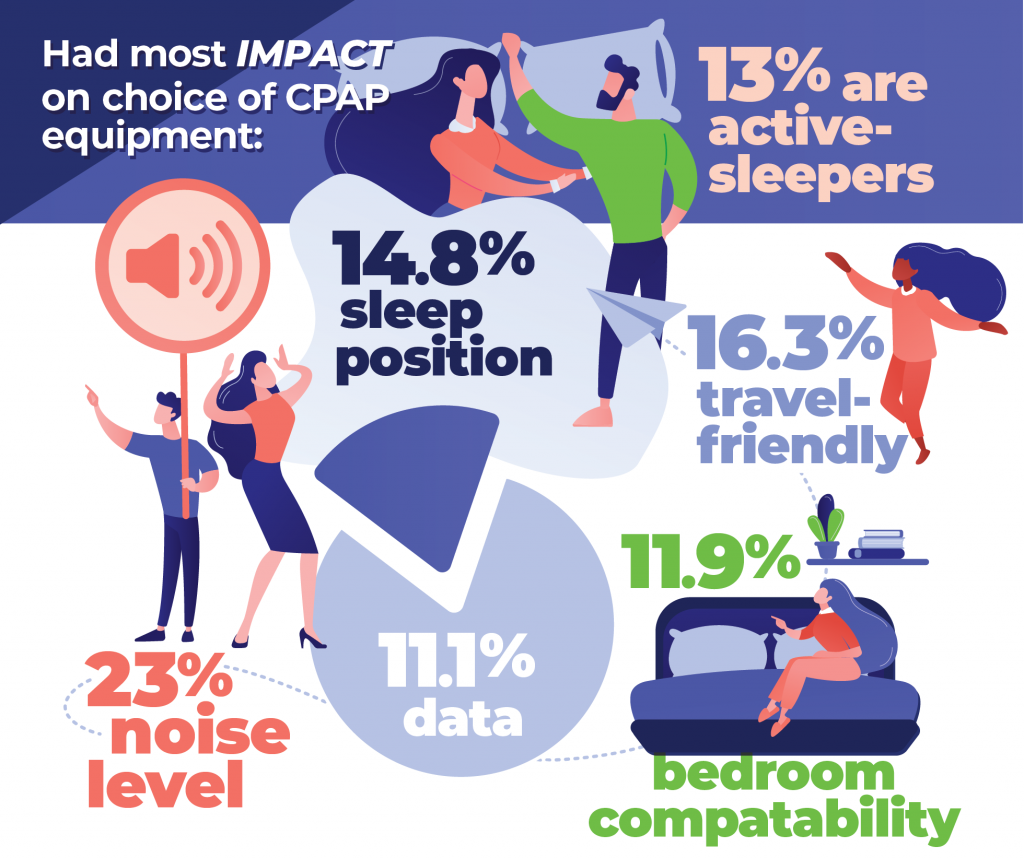 According to our study, 23% of respondents state that noise impacts their choice of CPAP equipment. Noise level and sleep play off of one another, and noisy environments often lead to the frustrating restless night of tossing and turning.
According to our study, 23% of respondents state that noise impacts their choice of CPAP equipment. Noise level and sleep play off of one another, and noisy environments often lead to the frustrating restless night of tossing and turning.
A recent study uncovered that while you sleep, your brain still catalogs and processes the sounds around you, which can have a physical impact on your heart rate or blood pressure. These physical effects will cause your brain to react and wake you up. Since your brain still works while you’re asleep, the greater effect of unwanted sound can cause you to wake up feeling frustrated and still tired. The Sleep Foundation explains that noises as low as 40 decibels and as high as 70 decibels can delay a good night’s sleep. Noises as repetitive as a dripping faucet or as disturbing as a loud neighbor will prevent you from falling asleep. Look for CPAP machines that are classified as whisper-quiet—within the 25-decibel range to not disturb you or your partner.
However, familiar sounds in your sleep environment like your fan, humidifier, or the gentle hum of your CPAP machine create a comforting feeling to help you fall asleep faster and not disrupt your sleep cycles. This is why packing your familiar travel CPAP machine or even your favorite alarm clock can help you fall asleep when traveling. When sleeping somewhere unfamiliar, your brain is on high-alert or in ‘watchdog’ mode on particularly the first night.
Researchers explain that the “first night effect” causes one side of your brain to do without sleep and remain alert to protect you from any potential danger. While you won’t scare off your brain’s natural watchdog response, traveling with familiar sounds like your CPAP machine and small comforting items can replicate the feeling of being at home. If your travel impacts your choice of CPAP equipment, rest assured that taking a travel machine with you can help to replicate your home environment thanks to the familiar therapy benefits and sound.
SnoozeStyle Factors and Mask Purchases
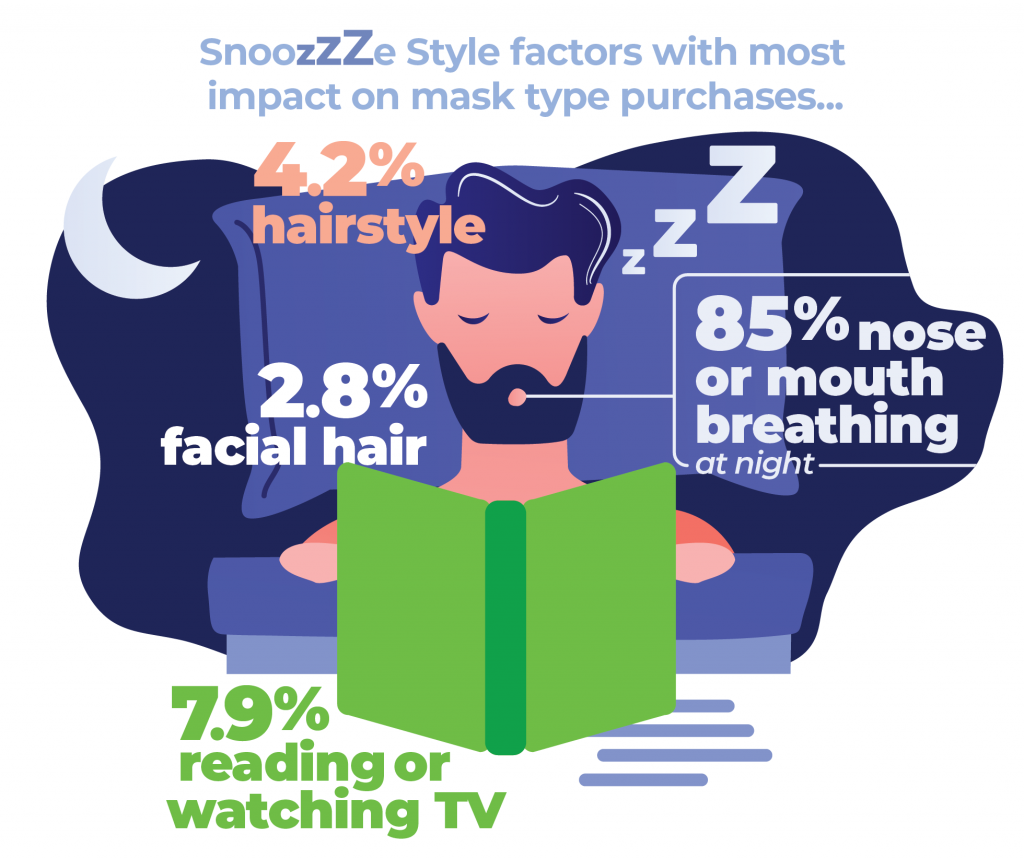
A majority, 85% of CPAP respondents, explained that how they breathe at night determines their mask purchase. With over four years of therapy, 55% of our respondents selected that nose vs. mouth breathing effected what CPAP mask they decide to purchase. But did you know that breathing out of your nose or selecting a nasal type CPAP mask can have major health benefits?
Researchers have discovered that breathing out of your nose helps to fight infections, facilitate better blood flow and lung strength, maintain your body temperature, and improve your automatic brain functions. Your nose makes nitric oxide, which helps your lungs take in oxygen. Your nose, in a way, “cleans” the air you breathe. Your nose houses both good and bad bacteria, which keeps us from ingesting the bad bacteria when initially breathing in.
When you breathe through your mouth, there is no barrier to keep the bad bacteria from entering in. Mouth breathing also has a negative effect on brain fog, fatigue, allergies, asthma, high blood pressure, heart disease, and more by depleting your carbon dioxide levels, lowering your blood circulation, and slowing your brain and in turn, your reflexes. If you do breathe through your mouth, we have full face mask options to ensure your therapy is uninterrupted.
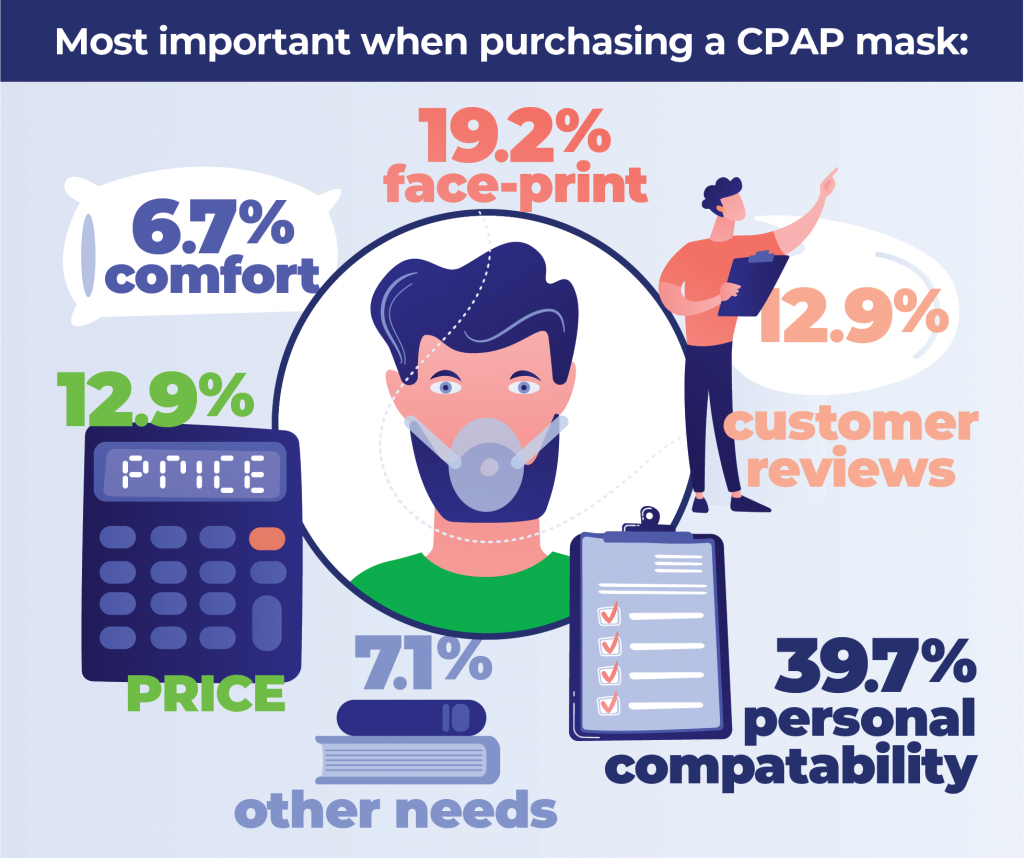
According to 39.7% of sleep apnea users we surveyed, their personal compatibility with their mask and how it works with their lifestyle and not against it was the SnoozeStyle factor that mattered the most.
In addition, 70% of respondents claimed that their sleep position impacted the type of mask they selected. Your sleep position can have a significant effect on your sleep quality and how you feel in the morning. According to a study from Healthline, sleeping on your side is most recommended—however, both sides are not equal!
Left Side: Sleeping on your left side helps ward off heartburn or GERD and helps aid digestion if you’re struggling with irritable bowel syndrome.
Right Side: If you suffer from heart conditions, sleeping on your right side may be better by helping to eliminate shortness of breath and encourage better cardiac performance. Your right side can also encourage fewer heart palpitations because your heart is in the center of your chest—where left side sleeping brings it to the chest wall, allowing you to experience each irregular heartbeat.
Regardless of left or right, sleeping on your side allows you to cleanse interstitial waste from your brain, lowering your risk of Alzheimer’s or Parkinson’s. Your brain’s “rinse cycle” needs quality, deep, and restful sleep to regularly eliminate the toxic waste from your brain.
Additionally, 19% of CPAP users we surveyed explain that the mask’s facial footprint determines which mask they purchase. Masks that do not fit your facial shape properly can lead to the dreaded claustrophobic feeling. Claustrophobia is defined by Psycom as the fear of being trapped in small spaces without having a way to escape. Select a mask that is comfortable for your own facial shape to prevent any feelings of being closed in.
Snoozestyle Factors and Machine Purchases
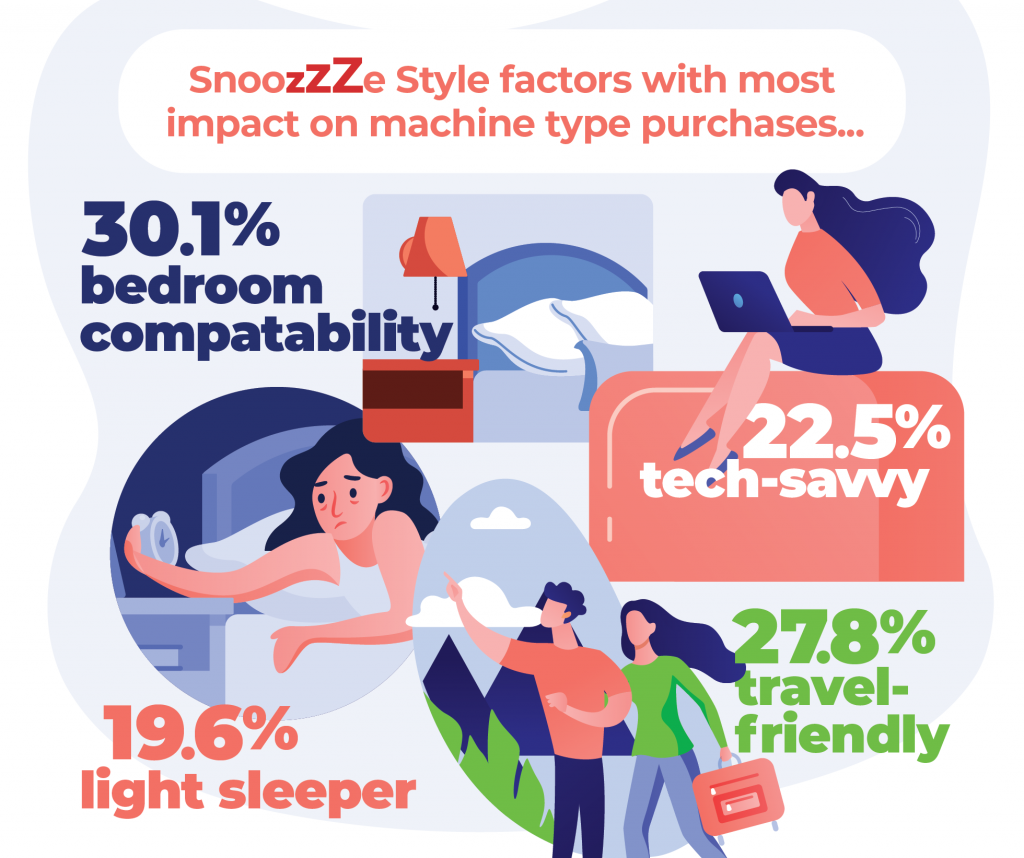
Twenty-two percent of respondents determined that a tech-savvy machine influenced their purchase. To act as your own CPAP advocate, a tech-savvy machine comes equipped with technology that allows you to stay in the know about your therapy progress.
Mobile Apps like the Philips Respironics DreamMapper App and the ResMed myAir App give you the ability to track your sleep data daily, set individualized goals, and receive personalized sleep tips. Choosing a machine that is technologically advanced gives you a platform to discuss any problems with your doctor in a data-backed, informed manner.
Light sleepers determined that their machine’s noise level impacted their choice. A study from Everyday Health explains that genetics, lifestyle, medications, alcohol, and caffeine may affect whether you fall into the light or deep sleeper category. Those who would classify themselves as light sleepers react to noise differently than deep sleepers, which can be caused by sleep spindles or brain waves.
Doctors hypothesize that if your body makes high-frequency sleep spindles, then you are likely classified in the deep sleeper realm and don’t react to loud noises. Enter the importance of having a quiet machine for light sleepers that doesn’t emit loud sounds throughout the night. Look for machines that are in the 25-decibels range to allow you to stay in a deeper sleep for longer.
By now, you are probably wondering what the most important machine features in our data were?
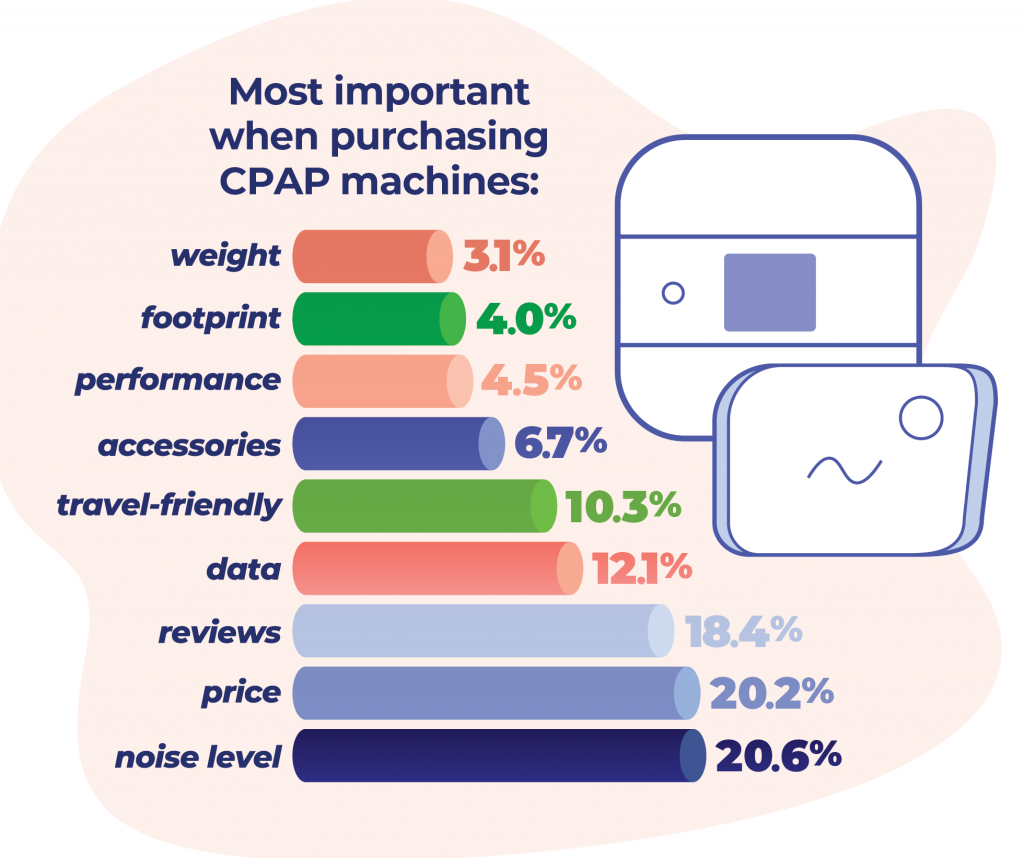
At CPAP.com, we have machines ranging in price to fit your preferred price point and noise level—remember, wink-wink, look for whisper-quiet.
But for those who are concerned with the bedroom compatibility mentioned above and the footprint of the machine, we have an overarching reason as to why it may be your SnoozeStyle concern.
When there is clutter in your bedroom or on your nightstand, it can unconsciously or consciously weigh on your mind. With loads of physical clutter, you will fail to rest and recharge throughout the night and wake up feeling ‘off’ throughout the day. Clutter on your nightstand can lead to stress and anxiety, which is the enemy to good sleep. We make CPAP machines that have a small footprint to not distract from your bedroom space. Eliminate unnecessary items from your nightstand to keep your space serene and clean.
Methodology
We surveyed over 226 people in total, focusing on a core sample who are CPAP users. We surveyed CPAP users who are just beginning their CPAP therapy and those who have been using therapy for over 30 years. Among our core group of respondents, 68% of CPAP users have been using their therapy for over four years. Twenty-three percent of respondents have been using their CPAP equipment for anywhere from less than a year to three years.
In some cases, questions and answers were rephrased or condensed for brevity or clarity. We had two fill in the blank sections that were combined with other questions to ensure data accuracy.
If these SnoozeStyle factors also ring true for you and you’re looking for the perfect equipment to match your lifestyle, we have you covered. Head over to our new lifestyle and comfort page to easily and quickly find the CPAP setup that works for you!
During this trying time in the World, you can order your CPAP supplies over the phone by calling Alaska Sleep Clinic’s labs on online through this website and we will mail your supplies directly to your home. You and your family’s health and safety is our top priority.



